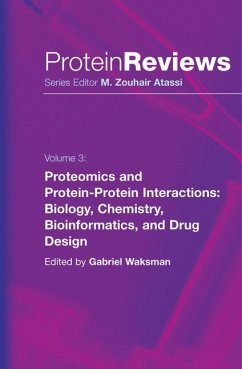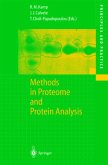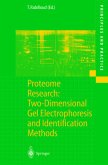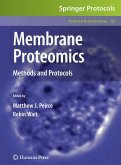The rapidly evolving field of protein science has now come to realize the ubiquity and importance of protein-protein interactions. It had been known for some time that proteins may interact with each other to form functional complexes, but it was thought to be the property of only a handful of key proteins. However, with the advent of high throughput proteomics to monitor protein-protein interactions at an organism level, we can now safely state that protein-protein interactions are the norm and not the exception. Thus, protein function must be understood in the larger context of the various binding complexes that each protein may form with interacting partners at a given time in the life cycle of a cell. Proteins are now seen as forming sophisticated interaction networks subject to remarkable regulation. The study of these interaction networks and regulatory mechanism, which I would like to term "systems proteomics," is one of the thriving fields of proteomics.
The bird-eye view that systems proteomics offers should not however mask the fact that proteins are each characterized by a unique set of physical and chemical properties. In other words, no protein looks and behaves like another. This complicates enormously the design of high-throughput proteomics methods. Unlike genes, which, by and large, display similar physico-chemical behaviors and thus can be easily used in a high throughput mode, proteins are not easily amenable to the same treatment. It is thus important to remind researchers active in the proteomics field the fundamental basis of protein chemistry. This book attempts to bridge the two extreme ends of protein science: on one end, systems proteomics, which describes, at a system level, the intricate connection network that proteins form in a cell, and on the other end, protein chemistry and biophysics, which describe the molecular properties of individual proteins and the structural and thermodynamic basis of their interactions within the network.
Bridging the two ends of the spectrum is bioinformatics and computational chemistry. Large data sets created by systems proteomics need to be mined for meaningful information, methods need to be designed and implemented to improve experimental designs, extract signal over noise, and reject artifacts, and predictive methods need to be worked out and put to the test. Computational chemistry faces similar challenges. The prediction of binding thermodynamics of protein-protein interaction is still in its infancy. Proteins are large objects, and simplifying assumptions and shortcuts still need to be applied to make simulations manageable, and this despite exponential progress in computer technology.
Finally, the study of proteins impacts directly on human health. It is an obvious statement to say that, for decades, enzymes, receptors, and key regulator proteins have been targeted for drug discovery. However, a recent and exciting development is the exploitation of our knowledge of protein-protein interaction for the design of new pharmaceuticals. This presents particular challenges because protein-protein interfaces are generally shallow and interactions are weak. However, progress is clearly being made and the book seeks to provide examples of successes in this area.
Hinweis: Dieser Artikel kann nur an eine deutsche Lieferadresse ausgeliefert werden.
The bird-eye view that systems proteomics offers should not however mask the fact that proteins are each characterized by a unique set of physical and chemical properties. In other words, no protein looks and behaves like another. This complicates enormously the design of high-throughput proteomics methods. Unlike genes, which, by and large, display similar physico-chemical behaviors and thus can be easily used in a high throughput mode, proteins are not easily amenable to the same treatment. It is thus important to remind researchers active in the proteomics field the fundamental basis of protein chemistry. This book attempts to bridge the two extreme ends of protein science: on one end, systems proteomics, which describes, at a system level, the intricate connection network that proteins form in a cell, and on the other end, protein chemistry and biophysics, which describe the molecular properties of individual proteins and the structural and thermodynamic basis of their interactions within the network.
Bridging the two ends of the spectrum is bioinformatics and computational chemistry. Large data sets created by systems proteomics need to be mined for meaningful information, methods need to be designed and implemented to improve experimental designs, extract signal over noise, and reject artifacts, and predictive methods need to be worked out and put to the test. Computational chemistry faces similar challenges. The prediction of binding thermodynamics of protein-protein interaction is still in its infancy. Proteins are large objects, and simplifying assumptions and shortcuts still need to be applied to make simulations manageable, and this despite exponential progress in computer technology.
Finally, the study of proteins impacts directly on human health. It is an obvious statement to say that, for decades, enzymes, receptors, and key regulator proteins have been targeted for drug discovery. However, a recent and exciting development is the exploitation of our knowledge of protein-protein interaction for the design of new pharmaceuticals. This presents particular challenges because protein-protein interfaces are generally shallow and interactions are weak. However, progress is clearly being made and the book seeks to provide examples of successes in this area.
Hinweis: Dieser Artikel kann nur an eine deutsche Lieferadresse ausgeliefert werden.
"While there are several books on Protemics on the market currently, Protemics and Protein-Protein Interactions is unique in that it focuses on technical issues and on the protein interactome itself. This very important and active research area is brought together by some of the leaders in the field to present a coherent entry point into a field that appeals to many. This will be a valuable and long-lived volume. It will certainly make a timely addition to any library or book collection." (Mark A. Lemmon, University of Pennsylvania School of Medicine, Philadelphia, Pennsylvania)








